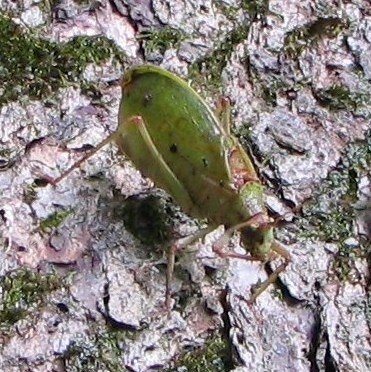 "As far as wildlife is concerned," Tallamy writes in Bringing Nature Home
"As far as wildlife is concerned," Tallamy writes in Bringing Nature HomeIn the face of this massive habitat loss, the land preserved as parks is just a drop in the bucket. If we really want to preserve wildlife, we must provide food and shelter in our backyards (and in the shared green spaces of our apartment buildings). And it turns out that what you plant for food really matters.
 Plant native plants. Plants have numerous chemical defenses against being eaten. And, over tens of thousands of years, specific insects have evolved the ability to overcome the defenses of specific plants. In fact, 90% of insect herbivores are specialists, relying on just one or a few plants. If you bring in a plant that hasn't grown in this area for tens of thousands of years, chances are, nothing will be able to eat it. This doesn't just matter for the insects, but also for the birds and other critters that rely on insects as their main source of food.
Plant native plants. Plants have numerous chemical defenses against being eaten. And, over tens of thousands of years, specific insects have evolved the ability to overcome the defenses of specific plants. In fact, 90% of insect herbivores are specialists, relying on just one or a few plants. If you bring in a plant that hasn't grown in this area for tens of thousands of years, chances are, nothing will be able to eat it. This doesn't just matter for the insects, but also for the birds and other critters that rely on insects as their main source of food.As many as you can. The more diverse and numerous the native plant population, the more numerous and diverse the insect population. And the more numerous and diverse the insect population, the more predators they will attract. That means birds -- and also ladybugs and other predatory insects. In contrast, with less diversity, there may not be a year-round source of food for these animals. And a less-diverse area has less ability to adjust if something goes wrong with a particular plant in a particular year.
 Especially trees. Tallamy and his research assistant compiled data on which tree genera support the most wildlife (using butterflies and moths as a proxy). The top five: oak (517 species of butterflies and moths), willow (456 species), cherry and plum (448 species), birch (413 species), and poplar and cottonwood (368 species). But while a single tree can be a tremendous resource for wildlife, it's important to also plant shrubs and perrenials; they'll create even more diversity.
Especially trees. Tallamy and his research assistant compiled data on which tree genera support the most wildlife (using butterflies and moths as a proxy). The top five: oak (517 species of butterflies and moths), willow (456 species), cherry and plum (448 species), birch (413 species), and poplar and cottonwood (368 species). But while a single tree can be a tremendous resource for wildlife, it's important to also plant shrubs and perrenials; they'll create even more diversity.Will my neighbors hate me? No. Native gardens can be just as formal as gardens full of non-native plants. And they'll love the birds and butterflies that you attract to your garden.
 Do I have to get rid of my non-native plants? Well, you can start by just adding natives to your existing garden. But consider that your non-native plants may cause habitat loss even in protected areas when they spread their seed by wind or by birds. Our local parks are full of English ivy, Japanese honeysuckle, Japanese barberry, privet, and other non-native plants commonly planted in yards. They are smothering out the natives that wildlife need to survive. (Check here for a list of some of the most problematic invasives in our area.)
Do I have to get rid of my non-native plants? Well, you can start by just adding natives to your existing garden. But consider that your non-native plants may cause habitat loss even in protected areas when they spread their seed by wind or by birds. Our local parks are full of English ivy, Japanese honeysuckle, Japanese barberry, privet, and other non-native plants commonly planted in yards. They are smothering out the natives that wildlife need to survive. (Check here for a list of some of the most problematic invasives in our area.)Insects? Really? Throughout the book are some amazing pictures and stories about the insects you might find on native plants. Not just creepy-crawly things, but beautiful butterflies and moths. You can also read about crickets that use the parabolic dish of a leaf to make themselves louder; milkweed bugs that migrate north with the ripening of milkweed seeds; treehoppers that communicate with each other by vibrating twigs; aphids that give birth to live young without a male's involvement; and the origins of Spanish Fly. It's enough to make you want to get out there and take a look. But, first there has to be something to look at. So...plant those native plants. As many as you can. Especially trees.


